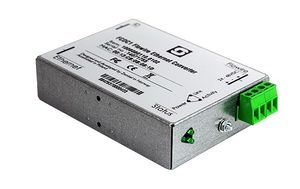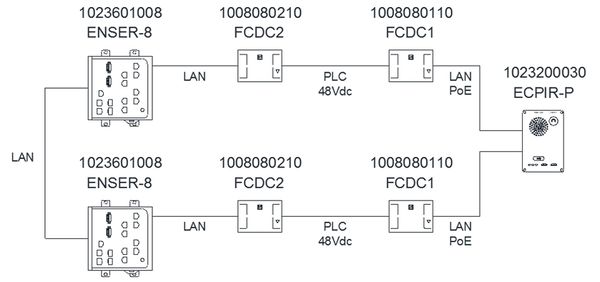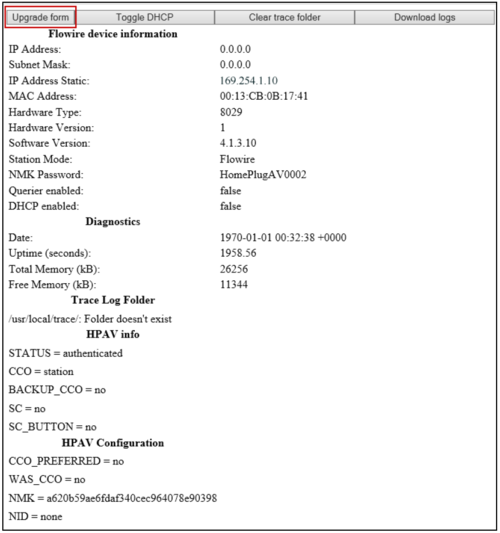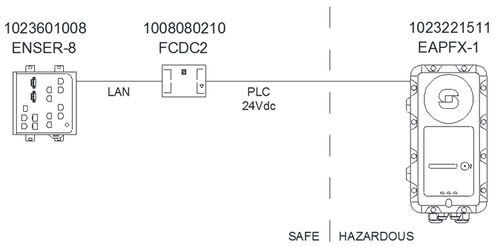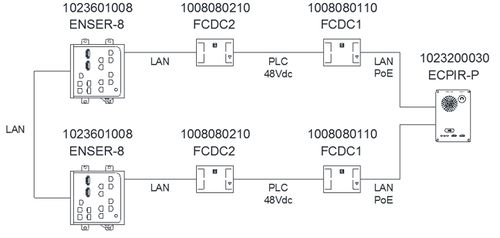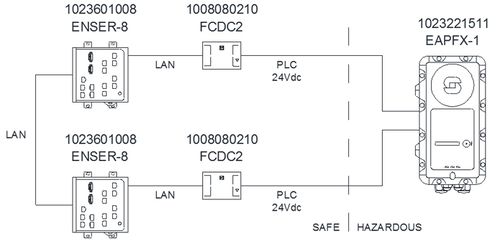Difference between revisions of "Exigo Flowire Guidelines"
(→Network Management Key (NMK) Configuration) |
(→Network Management Key (NMK) Configuration) |
||
| Line 86: | Line 86: | ||
[[File:Exigo flowire guidelines 2.PNG|thumb|left|500px|Flowire - web interface]] | [[File:Exigo flowire guidelines 2.PNG|thumb|left|500px|Flowire - web interface]] | ||
<br style="clear:both;" /> | <br style="clear:both;" /> | ||
| − | 2. Click the Upgrade form button | + | 2. Click the Upgrade form button <br> |
| − | + | 3. Enter a new password in the Flowire NMK field | |
[[File:Exigo flowire guidelines 3.PNG|thumb|left|500px|Flowire - web interface]] | [[File:Exigo flowire guidelines 3.PNG|thumb|left|500px|Flowire - web interface]] | ||
<br style="clear:both;" /> | <br style="clear:both;" /> | ||
| − | + | ||
| − | 4. Click Change NMK<br> | + | 4. Click '''Change NMK'''<br> |
The NMK Password must be between 8 and 64 characters long, and is case sensitive.<br> | The NMK Password must be between 8 and 64 characters long, and is case sensitive.<br> | ||
It is good practice to label the Flowire device with the new NMK.<br> | It is good practice to label the Flowire device with the new NMK.<br> | ||
Revision as of 11:23, 3 May 2017
This article aims to describe the recommended use of the Flowire Converter with the Exigo PA/GA system.
How to use Flowire
General
The Flowire Converters, FCDC1 and FCDC2, enable Ethernet to run on the same two wires as power, providing simpler cabling and opening up for longer cable hauls.
The FCDC1 is capable of powering Ethernet devices attached to it, such as IP PA panels with PoE Mode B. FCDC2 does not forward power to its Ethernet port.
Flowire can be used to support redundant connections, such as a PA panel connected to both main switches in an AB system. This requires a one-to-one connection to each switch.
Flowire also supports star configuration, meaning one-to-many. This configuration does not support redundancy. Different Flowire clusters must have separate Network Management Keys (NMK) to avoid detrimental results from crosstalk.
Flowire units meant to communicate with each other must use the same NMK. A cluster is here defined as all the Flowire units connected to one power supply.
Note!: In a redundant system, make sure the primary link between rack A and rack B does not utilize Flowire.
Power
Flowire Converters operate on 24VDC or 48VDC.
- 48VDC is required to power IP POE products, such as PA panels via the Ethernet port. Minimum voltage at remote Flowire unit to obtain PoE is 40VDC. Minimum voltage at EAPFX-1 and EAPFX-6 access panel is 18VDC.
- 24VDC is required to power Vingtor-Stentofon Ex panels: EAPFX-1 and EAPFX-6. These panels do not tolerate 48VDC.
Only FCDC1 forwards power via the Ethernet port. If this is not required, use FCDC2. Always use FCDC2 for connecting to the switch, as FCDC1 would forward power to the switch port.
Rapid Spanning Tree Protocol (RSTP)
Flowire can be used to connect redundant access panels. STP or RSTP is used in the switches and panels to prevent loops and other issues in the network. RSTP should be enabled to get the fastest response times if changes occur on the network.
Under ideal conditions, a panel utilizing RSTP can switch from its main connection to its backup connection in 10-20 ms if the main connection is lost. If a panel does not have a redundant connection, RSTP should not be enabled on the panel.
Note that in a redundant system, a panel cannot serve as a link between system A and system B (switch-to-switch) if RSTP is enabled. Panels with RSTP enabled will not forward traffic from one Ethernet interface to the next.
Ex panels (EAPFX) do not have RSTP capabilities, and will have longer switchover times than regular IP panels using RSTP.
After activating RSTP, connection to the panel must go through a switch. Direct connection from the PC to the panel will no longer work.
IGMP Settings
It is possible to configure IGMP settings in the Flowire web interface. The general guidelines are:
- Never enable IGMPv2 compatability mode on the Flowire unit closest to the switch.
- For device-side Flowire units, this setting is irrelevant, unless they are in a star configuration (see section 4.2.2).
- Never enable IGMP querier on Flowire when using a managed switch in the system.
For more info on IGMP settings, go to our wiki page on the subject.
Wiring, Connection and Screening with Flowire
The Flowire uses a high frequency signal for data communication, and could potentially interfere with other systems. To avoid this:
- Use a twisted, shielded pair for cabling
- Separate the different pairs/cables/links as much as possible
- The cable between the PSU and the Flowire unit should not be shorter than 50 cm
- All Flowires should be separated by at least 5 cm
- The cable shield should only be connected to ground in one place, on the rack side
- Redundant Flowire connections must be powered on separate electrical circuits
Network Configuration
Switch Configuration
Always use managed switches for redundant Flowire connections (panels or other IP products connected to two Exigo systems for backup purposes).
Flowire units in redundant configurations need to be configured as a trunk on the switch, with native VLAN 1.
Where available, such as on advanced Cisco switches, storm control should be implemented to block rogue ports in a network storm if spanning-tree fails.
The storm control will block the ports as soon as it reaches the configured threshold on the port, and resume to forwarding states after it has returned below the safe level.
Cisco Switch configuration for trunk port:
- interface FastEthernet1/1
- description FLOWIRE LINK
- switchport mode trunk
- switchport nonegotiate
- storm control broadcast level pps 350 150
- storm control multicast level pps 350 150
- storm control action shutdown
- spanning-tree guard loop
Flowire units without a redundant link is treated as an end point and should be configured as an access port with portfast. When portfast is configured on the port it will always be in forwarding state.
Cisco switch configuration for access port:
- interface FastEthernet1/2
- description FLOWIRE ACCESS PORT
- switchport mode access
- switchport nonegotiate
- spanning-tree portfast
- spanning-tree bpduguard enable
Network Management Key (NMK) Configuration
The NMK is configured in the Flowire’s web interface.
To set a new NMK password:
1. Log into the Flowire device by entering its IP address in a web browser. The default IP address is 169.254.1.10.
2. Click the Upgrade form button
3. Enter a new password in the Flowire NMK field
4. Click Change NMK
The NMK Password must be between 8 and 64 characters long, and is case sensitive.
It is good practice to label the Flowire device with the new NMK.
Default NMK: HomePlugAV0123
Flowire Configurations
One-to-One Connection
For optimal results, a one-to-one connection should be used. This will ensure the most stable connection, with low loss of data packets, and also make it less vulnerable to faulty and shorted wires in other systems.
A one-to-one connection can be wired in 4 different ways in an Exigo system.
Option 1: Single Connection - 2 Flowires
When no redundancy is required, a single link using two Flowires is used - one FCDC2 in the rack, and one FCDC1 at the panel end. If the single connection fails, communication with the panel will be lost.
When using more than one Flowire connection (when supporting more than one panel via Flowire), each connection must utilize a separate NMK.
If it is not desired to power the panel via the Ethernet port, use FCDC2 at the panel end and connect a power supply to the panel.
Option 2: Single Connection Ex Panel - 1 Flowire
When no redundancy is required on an Ex panel (EAPFX-1 or EAPFX-6), a single link using one FCDC2 in the rack is sufficient. Ex panels have Flowire technology integrated on the main board. If the single connection fails, communication with the panel is lost.
When using more than one Flowire connection (when supporting more than one panel via Flowire), each connection must utilize a separate NMK.
Ex panels must be powered via the Flowire in the rack using 24VDC power supplies only.
Option 3: Redundant Connections - 4 Flowires
When redundancy is required, use two Flowire links, one for system A and one for system B, consisting of two Flowires each. One FCDC2 in each rack is connected to one FCDC1 each at the panel end. Each FCDC1 is connected to one Ethernet port on the panel.
If the system is configured correctly, one Flowire connection can be lost without losing communication with the panel. Switchover time will depend on whether or not the panel is configured to use RSTP.
Each connection should use a separate NMK, one for the A system and one for the B system.
When using more than one Flowire connection from each rack (when supporting more than one panel via Flowire), each connection must utilize a separate NMK.
If it is not desired to power the panel via the Ethernet port, use FCDC2 at the panel end and connect a power supply to the panel.
Note: The two Flowires at the panel end could in theory be replaced by one Flowire.
This is not recommended as each connection would be vulnerable to short circuiting on the other connection. It would, in practice, constitute a single connection between two systems, using only one NMK.
Option 4: Redundant Connections Ex Panel - 2 Flowires
When redundancy is required on an Ex panel (EAPFX-1 or EAPFX-6), two links using one FCDC2 in each rack is sufficient. Ex panels have Flowire technology integrated on the main board.
If the system is configured correctly, one Flowire connection can be lost without losing communication with the panel. Switchover time should be 7-10 seconds. RSTP is not supported on Ex panels.
The Flowires in each rack and the Flowire in the Ex panel must have the same NMK.
When using more than one Flowire connection from each rack (when supporting more than one panel via Flowire), each connection must utilize a separate NMK.
Ex panels must be powered via the Flowires in the racks using 24VDC power supplies only.
Note: Make sure the primary link between rack A and rack B does not utilize Flowire.
4.2 Star Connection - Challenges
Star connections are not recommended, and should only be used if absolutely necessary.
The star connection should NEVER be used with redundant connections.
Multicast issues have been observed when using star connections.
